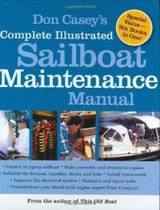Hold the oysters!
We’ve just been to a blue water seminar this past weekend at the Cruising Association – and it was awesome. 7 lectures on how to cruise that were of riveting and relevant interest. Couldn’t get more near and dear to our heart than that.
Vyv Cox, a mechanical engineer who has written quite a few articles for Yachting World, etc*, led off with a talk on ‘mid-ocean things that could spoil your day’.
Well, yes. And most of them involved metal fatigue and corrosion. The kind of thing that causes masts to come down and boats to sink. Sure made for some edge of the seat listening.
But good news – although you cannot eliminate all risk and there are no guarantees, you can take steps to minimise the chances of quite a few scary situations.
Most of them involve sealants, choosing the right materials and check, check, checking your equipment. Good stuff.
Here’s what we learned…
Corrosion
Galvanic corrosion
- 2 metals in salt water generate electricity… and causes one of the metals to corrode preferentially
- common example: stainless steel and aluminum
- antidote:
- isolate different metals
- avoid using different metals close together if possible
- exclude water – use sealants to protect eg. Duralac paste, tefgel
Crevice corrosion
- if water covers the top of a crevice – then air is excluded and corrosion can occur
- thread roots are crevices – eg lower swaged ends of shrouds are suspectible
- so keep water out – fill it with sealant, lanolin, Waxoyl
- Waxoyl is available in an aerosol – warm up the shrouds with a hot air gun, then spray the Waxoyl on
General corrosion
- is materials related
- is unlikely with 300 series stainless steels
- carbon steel is suspectible but generally not used except in engines, engine components, mountings, chain etc
- NOTE: Jeanneau only uses 400 series which is not very anti-corrosive
Seacocks & Fittings
How to avoid corrosion… choose your materials well
- EU regulations only require fittings to be good for 5 years (Huh? Yep, the wrong seacocks can sink your boat…)
- brass suffers from dezincification – the loss of zinc from brass
- the fitting will show the pinkish colour of copper on it
- it may only affect the surface but severly reduces strength
- thread roots are particularly susceptible
- if the fittings are chrome-plated – then they are brass
Where to find these short-life brass skin fittings?
- Tonval, Guidi products – all brass
- Manganese bronze… is brass (and some other metals mixed in) – often found in propellers
- Naval brass = brass
Who uses brass skin fittings?
- Beneteau
- Dufour
- Hallberg-Rassy
- Malo
- Maxi
- Najad
- X Yachts
- …
Yeah. Surprised us too.
So what materials should your seacocks and skin fittings be made of?
If you discover you do have brass fittings, then it’s time to replace them with the good stuff… And yes, it costs a lot.
- DZR is the good stuff – it includes arsenic which slows corrosion (cZ132Cu62Zn35.2Sn0.7Pb2As0.1)
- NOTE: no DZR is chrome-plated
- The symbol ‘CR’ (corrosion resistant) means it is DZR – but only if you see this symbol on valves!!
- Mysteriously Guidi’s brand symbol on skin fittings looks a lot like ‘CR’… but Guidi = brass. Be careful!
- ASAP brand made with DZR
- Blakes seacocks also made with DZR (at least for the last 25 years)
- Bronze – very good… and expensive
What else should you do to protect your boat from corrosion?
For mountings on hull use:
- Sikaflex 291
- 3M 5400
- Pu40
- Boatlife Lifecaulk
For threads use:
- Liquid PTFE
- Sikaflex 291
- PTFE tape
re: Bonding
- If you have bronze or DZR you don’t need to seal because your fittings will not corrode.
- (If you do bond, then you will create a galvanic situation.)
- Bonding is done in North America, not in the EU/UK.
re: Anodes
- Be careful where you place your anodes – they work only on ‘line of sight’. If you place them on the other side of an obstacle (say, a hull…) then they won’t work and can even make matters worse.
Fatigue
- Fractures occur due to cyclic stress.
- eg shrouds and stays, fittings, masts, shafts
- eg if you let off the back stay every time you are at the dock, then you incresae fatigue in mast which could lead to failure (hmmm, the boat we train on does this…)
- Therefore eliminate stress raisers and allow freedom of movement.
- (So, does this mean never put the backstay on? Or leave it on all the time?…)
- Failure of bolts are always due to not being tightened enough, which allows play, leading to fatigue and failure.
- Make sure that swaged fittings are in line (no ‘banana’ swags or cracks) and that toggles are on all ends.
- Inspect all of the mast and mast fittings for cracks
- Low profile T-ball fittings are best.
Have you ever been caught on the wrong side of corrosion? What did you find the last time you inspected your mast?
We will certainly be going over Un Tigre Beau‘s mast with a giant magnifying glass this winter I can tell you…
–Captain Cat
(transcribed by the Can Opener)
* coxengineering.sharepoint.com



